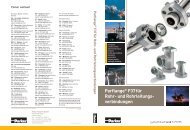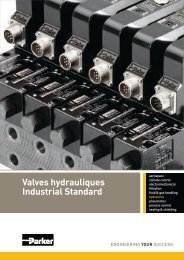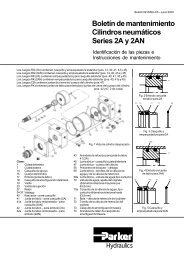Vaporizable Dielectric Fluid Cooling of IGBT Power Semiconductors ...
Vaporizable Dielectric Fluid Cooling of IGBT Power Semiconductors ...
Vaporizable Dielectric Fluid Cooling of IGBT Power Semiconductors ...
Create successful ePaper yourself
Turn your PDF publications into a flip-book with our unique Google optimized e-Paper software.
ehavior at temperature extremes, or another variant filtered<br />
and controlled to meet certain requirements. Requirements for<br />
purity, corrosively, and electrical resistivity for water and<br />
electrically-conductive liquids may be highly specific in certain<br />
electronic cooling systems. [1, 2]<br />
In avionics and other airborne applications, a common<br />
liquid coolant is polyalphaolefin (PAO). In semiconductor<br />
manufacturing equipment, test equipment, certain types <strong>of</strong><br />
laboratory instruments, and immersion cooling applications in<br />
locomotive traction and other specialized markets, use <strong>of</strong><br />
dielectric electronic liquids such as 3M Company’s<br />
Fluoroketone (FK) liquids has been documented in the<br />
literature. [3]<br />
Use <strong>of</strong> each <strong>of</strong> these liquids represents an engineering<br />
selection process by the system thermal/mechanical<br />
engineering team to meet performance and cost requirements<br />
and program objectives (availability and logistics for certain<br />
liquids, electrical requirements, availability for field<br />
replacement, among others). These requirements are specific<br />
to each application type; the liquid selection is one component<br />
<strong>of</strong> the liquid cooling design process.<br />
A major system decision point is the selection <strong>of</strong> a single-<br />
versus two-phase liquid system design, primarily determined<br />
by source heat fluxes and design targets for maximum thermal<br />
performance. Use <strong>of</strong> single-phase liquid cooling systems with<br />
a water coolant [either deionized water or water/glycol<br />
mixtures such as propylene glycol (PEG), or ethylene glycol<br />
(WEG)] is the predominant liquid system solution globally for<br />
electronics thermal management. Deep engineering knowledge<br />
exists at many OEM companies, universities, and research<br />
institutions. There is a large and well-established component<br />
vendor base worldwide. Principal system components include<br />
a pump, heat exchanger, fans, one or multiple liquid cold<br />
plates, filters, expansion tank, flow meters and other control<br />
components, and a deionization unit (with field-replaceable<br />
deionization cartridge, for deionized water systems).<br />
Single-phase water/ethylene glycol cooling is also the<br />
predominant liquid cooling solution for the automotive market<br />
globally, for internal combustion engine (ICE) cooling. The<br />
same is also true for the traction market globally, for dieselelectric<br />
and electric-drive passenger and freight locomotives,<br />
high-speed trainsets, and electric multiple unit and urban transit<br />
railcars in many forms. The use <strong>of</strong> single-phase water cooling<br />
is obviously well-established and field proven for simplicity,<br />
even in the simplest implementation for engine block heat<br />
removal – where there traditionally have been no concerns for<br />
relatively temperature-sensitive power semiconductors and<br />
microprocessors and other electronic devices.<br />
Use <strong>of</strong> pumped vaporizable dielectric liquid systems where<br />
boiling is induced is less common in electronic system thermal<br />
management. Historically, much research work has been<br />
conducted in two-phase cooling at universities and industry,<br />
including large heat exchange and cooling systems for power<br />
plants and other non-electronics applications. In computing<br />
and electronics, development work has included such concepts<br />
as IBM Corporation’s Liquid Encapsulated Module (LEM),<br />
from the early 1970s, and more recent research and production<br />
implementation <strong>of</strong> both water cooling and refrigeration for<br />
large enterprise servers. [4]<br />
Significant current research and development work<br />
continues today with liquid boiling and liquid immersion,<br />
conducted by universities, research institutions, and at coolant<br />
liquid suppliers such as 3M Company. [5]<br />
C. Why Pumped <strong>Vaporizable</strong> <strong>Dielectric</strong> <strong>Fluid</strong> Solutions?<br />
Very strong market needs for improved thermal<br />
management solutions, as source heat fluxes increase rapidly<br />
in many types <strong>of</strong> systems, has led to renewed investigation <strong>of</strong><br />
two-phase systems which <strong>of</strong>fer a practical and cost-effective<br />
next step beyond single-phase liquid cooling. The<br />
development and use <strong>of</strong> two-phase systems which utilize a<br />
pump but not a compressor (as is used for vapor cycle<br />
refrigeration) yields an additional tool in the thermal engineer’s<br />
toolbox that does not require the further step to full vapor cycle<br />
compression refrigeration. A two-phase thermal management<br />
system may be appropriate for power inverter designs for HEV<br />
applications where sub-ambient cooling is not required.<br />
The primary objective in system design for considering a<br />
two-phase liquid system, as compared to single-phase liquid, is<br />
to harness the substantial increase in overall thermal<br />
performance obtained with boiling phenomenon. A typical rule<br />
<strong>of</strong> thumb for two-phase systems is that the heat <strong>of</strong> vaporization<br />
principle will yield a two- to four-times increase in total heat<br />
transport capability.<br />
Heat <strong>of</strong> vaporization is utilized in simple and effective heat<br />
pipe and vapor chamber designs used widely in electronic<br />
systems. Both heat pipes and vapor chambers are well<br />
understood and represent a highly useful component that can be<br />
easily applied to solving thermal problems without the<br />
encumbrance <strong>of</strong> pumps, compressors, and other components <strong>of</strong><br />
a loop liquid cooling system. However, the total capacity <strong>of</strong><br />
heat pipe and vapor chamber designs is significantly lower than<br />
that <strong>of</strong> a pumped two-phase system.<br />
In operation, pumped VDF thermal management systems<br />
are self-optimizing. System operation is controlled by the heat<br />
load: as the power load increases as switching increases and<br />
heat dissipation rises, the amount <strong>of</strong> boiling increases to<br />
withdraw the incremental heat load. As the power load<br />
decreases as work slows, the boiling rate decreases. These<br />
near-instantaneous changes provide a self-regulating feature for<br />
two-phase systems.<br />
A pumped VDF system provides an excellent intermediate<br />
step after single-phase water and heat pipes and vapor<br />
chambers have been considered. A pumped two-phase system<br />
employs heat <strong>of</strong> vaporization principles and adds the benefit <strong>of</strong><br />
a pump to multiply the potential heat removal capability.<br />
Why might traditional vapor cycle compression not be the<br />
next obvious step, to move directly to the use <strong>of</strong> refrigeration<br />
and the obvious advantages <strong>of</strong> obtaining sub-ambient cooling?<br />
Refrigeration provides an excellent, compact solution for high<br />
heat flux thermal management. Vapor cycle compression is<br />
required where maximum operating temperatures must be<br />
observed with a relatively low rise over ambient temperature;





